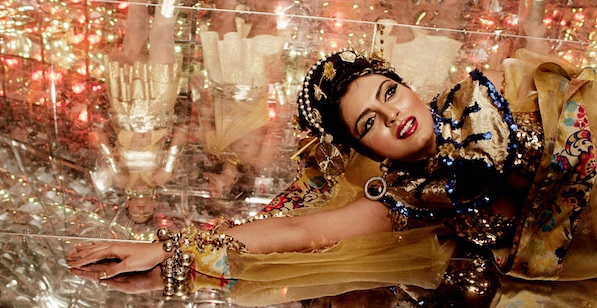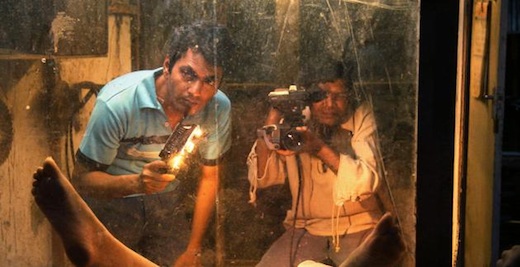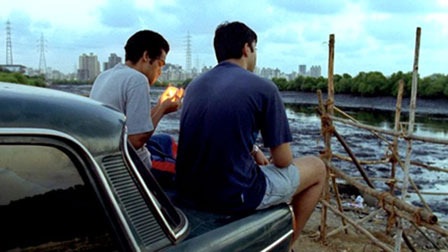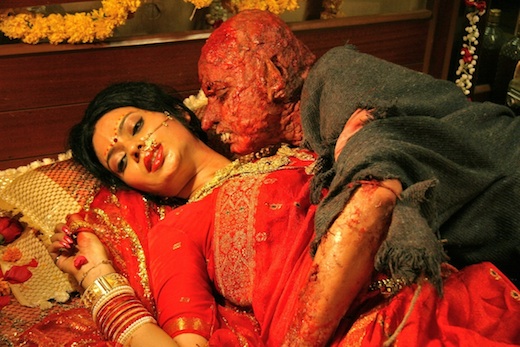The early success of Indian director Ashim Ahluwalia offers reassuring evidence that independent filmmakers don’t necessarily have to be monomaniacal self-promoters and tireless networkers. A would-be engineer whose path was irrevocably subverted by an encounter with experimental film at an American college, Ahluwalia has no allegiance to the rules, borders or expectations of moviemaking. Upon completing his debut feature, John & Jane, shot over a couple years on film pilfered from his jobs directing TV commercials, Ahluwalia had no clue how to devise a festival and distribution strategy. When the Toronto International Film Festival called in 2005 to invite his darkly funny and deeply disquieting documentary about youthful Indian call-center workers besotted with American dreams, Ahluwalia thought someone was pranking him. A sales agent by the name of John Sloss then phoned to pitch his services; it wasn’t until much later that Ahluwalia learned he was the most sought-after dealmaker in independent film.
John & Jane went on to screen at Berlin, and was sold to more than 16 countries. (In the U.S., it was the first Indian film bought by HBO.) Ahluwalia was offered a Bollywood feature to direct, but turned it down to develop a documentary about India’s illegal and shadowy exploitation-film industry. Researching the film was a hoot, but his voluble subjects refused to talk on camera so Ahluwalia channeled their stories into a garishly entertaining narrative feature funded in part by Global Film Initiative, Miss Lovely, which premiered at the 2012 Cannes Film Festival in the Un Certain Regard section.
It’s as impossible to predict—or copy—Ahluwalia’s career path as it was to anticipate it; his next project, if all goes well, is a science-fiction film he’ll shoot in Kazakhstan. He spent several weeks in the Bay Area this spring as an artist-in-residence at the San Francisco Film Society (parent of the S.F. International Film Festival), speaking at high school and college film classes and showing and discussing his work. Following a spirited conversation over lunch at a Divisadero pizzeria (where it was too noisy to record the conversation) and a hit of espresso at a nearby café (likewise), we found a sunny, windy stoop to conduct our interview.
Keyframe: Let’s begin with your entreé to film at Bard College in New York.
Ashim Ahluwalia: Bard was a place I went to accidentally, and the fact that it was a school that focused primarily on experimental film made it very interesting for me to come at film from a way which is primarily non-narrative. It was coming at it from film as a language, film as a form and a structure, rather than film as a story. That did change my outlook with regard to storytelling. I just didn’t accept given forms of filmmaking as easily. I questioned why we had to tell a story in a particular way, or why a documentary had to play out in a particular way.
Keyframe: Did you aspire to make films before you went there?
Ahluwalia: It was a school that I got into ’cause I didn’t take the SATs. At that time, it was a way for me to get out of India and have a new experience. But I kind of fell into filmmaking accidentally: I took an experimental film class and it blew my mind. The first thing we saw was Michael Snow and it wasn’t a narrative, it was a piece of film that had chemicals on it running through the projector. It was more like a painting. And that really exploded my idea of what a film could be. This idea that a film can pretty much be anything that runs through a projector, or can be watched on a screen, suddenly liberated me from so many ways of thinking about film. My student work tended to be experimental and handmade, a lot of hand processing, a lot of formal experiments. But I was always interested in narrative as well. Unlike a lot of filmmakers that came out of Bard, I didn’t completely abandon narrative. I just felt there that were a lot more ways in which I could engage narrative. So for me, the narrative feature film still remained interesting as an idea, but I wanted to combine formal ideas—the criticality that I brought from the experimental film world—into more traditional forms of making films.
Keyframe: Was there a structure or place to do that in India?
Ahluwalia: Going back to India was quite a trauma because I ended up going into an industrial way of making films, going straight into the film industry, working as an assistant on films that were very traditional and very far from the types of films that I wanted to make. But the good thing about that was that I began to understand the need to subvert expectations, not to start from scratch by building an experimental film culture but working the experimental nature of my work, or the formal nature of my work, into genres that were accepted. Something that could be understood was the idea of making a documentary on a subject. So my first film, John & Jane, was really about, in a way, tricking financiers and crew to accept the idea that I was making a conventional issue-based film on the idea of outsourcing. But of course when I made the film itself, it became much more dreamlike and much more about the psychology of that universe. But initially that’s something that came from the industry, the idea that I have to work within parameters that people understand. Yet I want to try and get my own formal ideas of filmmaking or my own personal vision in there. So this conflation of industry and experimentalism is what happened when I went back to India.
Keyframe: Did you also want to provoke a different response in audiences than the response conditioned by conventional documentaries and narratives?
Ahluwalia: Yes, my issue with the experimental film world was always that it was so closed, it was so cloistered, and so many of those amazing visions of what a film could be never really [got] outside those very narrow confines. One of the exciting things for me has been to be able to use ideas from all kinds of different cinema in a very un-self-conscious way, putting things together that would not otherwise be considered acceptable. Throwing those together and bringing that into a realm where I happen to get distribution, or I happen to be widely seen for the kind of films that I make, or there’s a kind of an audience for the stuff that I’m interested in making. Yet many of these audiences have never seen a lot of the films that I’ve gotten very excited about watching. So in a way, on one hand it is me making my own work but it’s also a dissemination of a kind of film culture that I feel is otherwise inaccessible for a lot of people. It’s a way to make links between little niches of the filmmaking community that don’t talk to each other.
Keyframe: One of the great illusions of documentary is that the subject is unaware of the camera’s presence. You addressed this directly in John & Jane, and refused to do that dance with either your subjects or the audience. What did you say to your subjects, to convey your goals for the film and to set their expectations?
Ahluwalia: I’m very conscious of the fact that documentary is the greatest cinematic fraud that ever has been. The idea of objectivity, and the idea that this is just a piece of footage that’s been recorded accidentally and presented to the world in an unbiased form, is kind of an outrageous thought. So for me the beginnings of John & Jane really were coming from questioning many of these things that we expect a documentary to be. One was this idea that people can perform in front of the camera as if the camera is not there, and that to me is kind of a silly idea. Instead of engaging that dishonesty I thought it would be much more honest to just tell the subjects of the film that they are going to be in a film, and how do they see themselves performing their lives for the camera? It became a kind of collaboration where they were reenacting themselves for the camera rather than pretending like the camera was not there, which I just don’t understand what that would entail.
Keyframe: In a sense what you’re documenting is not objective reality but their subjective view of themselves. At the same time you’re commenting on how they see themselves.
Ahluwalia: Yes, all of us watch so much media that we’re essentially performing ourselves with reference to other media characters or personalities that we’re watching. The idea that we don’t exist in a way where our personalities are independent of the media that we watch—we’re kind of built up from that media. And in a way we’re all performing all the time. This idea of performance in documentary, to me is very interesting and very central, because when you film someone they are very clear of how they would like to represent themselves. And instead of being naïve about that, it’s interesting for documentary filmmakers to take that onboard and absorb that as part of the formal interest in reenactment. In fact, everybody’s reenacting themselves all the time in every documentary. That’s what they’re doing.
Keyframe: When you embarked on the project that evolved into Miss Lovely, were you intending to blur the distinction between nonfiction and fiction? What was your original concept?
Ahluwalia: The idea with John & Jane was, on one hand, a film about six characters that work in a call center. On a very basic level it is real people in real spaces, so it technically qualifies as a documentary. But a lot of the themes and a lot of the imagery from that universe reminded of science-fiction films that I’d seen as a kid from the seventies. The American science-fiction films like Westworld and Brainstorm and Altered States. So in some strange way there was a conflating already in my mind of the present-day, contemporary world with this science-fiction vision that I’d seen in the seventies of 2005, when John & Jane was made. The idea of this being a traditional documentary never occurred to me. It started as a kind of vision of the future, but in the present. There is no science fiction because we’re already there, we’re already in that world. This approach determined a lot of formal things about fiction and nonfiction, and the feeling you always have that while you’re watching someone who’s real, you’re also watching something that could potentially have been written as script. You’re constantly pinching yourself over whether this is real or a dream reenacted. Or is it the filmmaker manipulating me? I like films that make you conscious about manipulation.
Keyframe: When you started Miss Lovely, did you plan to do a straight documentary?
Ahluwalia: Just like with John & Jane, where I had a documentary that looked more like a science-fiction film at times, Miss Lovely became—and people joke about this, ‘Your fiction film looks more like a documentary than the documentary you made.’ Miss Lovely started out as a documentary: I wanted to make a film about the C-grade sex-horror film industry in India that was illegal and very difficult to access, and I spent a year and a half hanging out with a lot of people in that industry trying to get access and trying to get them to tell their stories on camera. Although I got a lot of amazing insights, nobody wanted to be on film. So I ended up having to rework all those stories and real characters into a semi-fictional screenplay. Because of all the illegality and the criminality, I had to set it in another time. I set it in the eighties, in a way protecting some of the people who had told me these stories. Strangely, even though the people that were from that world, the C-grade actors and directors, didn’t want to be in the documentary, when I asked them if they would reenact their own roles and their own lives as fiction, they were more than happy to dress in period clothes and costume and appear on camera. So I ended up using a lot of the real people that should have been in the documentary as actors in the film.
Keyframe: What does that say about the way people think of movies?
Ahluwalia: More and more when I watch films and work on films, I see that the lines between what a documentary is and what fiction is, all these categories are so absolutely artificial. I feel like a lot of times when you watch fiction films from the 1920s or 1930s, they appear to me like documentaries—or documents—of the time. I’m engaging a lot less with the narrative or the performance than I am with the size of the doorways or the way cars drive or how somebody dresses or how somebody physically moves through space. So fiction, as Godard has often said, ends up looking in retrospect like great documentary. Once you understand that, it becomes very difficult to treat a narrative feature film where you ignore the real. I think the real is very important to me—the things that happen by mistake, accidents, things that happen when you yell ‘cut.’ An actor might be pissed off or upset about their performance, and that sense of being upset or outraged is more interesting than the performance itself. That might actually work better for the scene than the scene that you convinced yourself was very realistic.
Keyframe: How do you get those shots?
Ahluwalia: I almost never cut the camera when I say ‘cut.’ I always have a lot of post-roll, and a lot of pre-roll before the actors begin to do their thing. Often what you see before you say ‘action’ is a kind of strange introspection, a certain kind of personal universe that the actor goes into where they’re prepping for their part. They haven’t really begun acting, and they haven’t really left themselves as real people yet, so that’s the moment when documentary and fiction start coming together, before they start performing. I think those moments in films are really interesting, when you use things that the actors are not expecting you to use.
Keyframe: This approach strikes me as fascinating, perverse and risky. Can you speak a little more about it?
Ahluwalia: In Miss Lovely I used it a lot, because I worked a lot with non-actors who were not able to deliver lines, and even when they did deliver lines the lines were unconvincing. Yet when that same actor would be lying on a bed frustrated that they couldn’t remember their lives, that footage ended up being so much more beautiful and poetic and real. So in a way I forced myself to abandon the script as I got more and more interesting pieces of footage that were accidental. I worked them back into the story in places they were not designed to be. Because of my documentary background, I was loose enough to say, ‘I’m going to go with this. It just seems better than what I’ve written.’
Keyframe: It’s an organic way of working, but I don’t think a lot of filmmakers—narrative or documentary—would be comfortable. They want to capture the magic, but—
Ahluwalia: The thing about the magic is it usually disappears when you yell ‘action.’ The tragedy about fiction filmmaking a lot of times is you’re not getting any real magic, but what you’re getting is a kind of reenacted magic. Sometimes that’s good and sometimes that works and a lot of times it doesn’t. I often will cut a shot and we’ll pack the camera up and I’ll leave the room and I’ll see something that is so incredible that I wish that was in my film. Unfortunately, the problem with the way fiction filmmaking happens is that we try to control everything so that there’s no life left in it. By the time we come around to shooting it, it’s like trying to shoot a wild animal in the forest and you brought all the lights out, and by the time you come out that animal’s gone. That magic is as evasive as that. It’s not something that you can control. It’s something that happens in the cracks.
Keyframe: You’ve confided that when you need inspiration, or are in a down mood, you watch Faces or Shadows. How did Cassavetes capture the magic? I suppose one could say he cast wild animals.
Ahluwalia: Cassavetes is interesting because primarily he worked for his bread and butter as an actor in Hollywood. I think he understood, watching that process up close, how you can really kill any sense of spirit when you overproduce something. When he wanted to make his own works he did the exact opposite, which is that he left things loose. He allowed for uncontrolled cinema, a state which is very wild, and then he made a lot of that happen in the edit. This route, to accept things that come in from the outside while you’re making a film, that’s something that you have to be very confident about. Especially in the early Cassavetes films, you see that a lot, the space to allow a certain kind of spirit in. You have to be ready to see that spirit when it’s in the room. You have to be attuned to a certain thing that’s happening, and know that you’re getting it somehow. It’s very intuitive; it’s not necessarily a spoken thing or even something you can conceptualize. It’s something that you just know is happening because all the elements have lined up almost in a semi-religious way.







